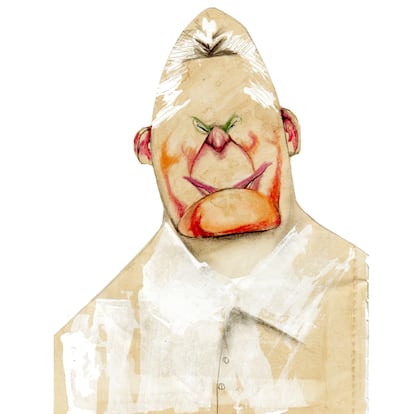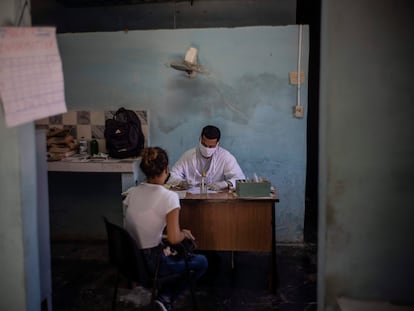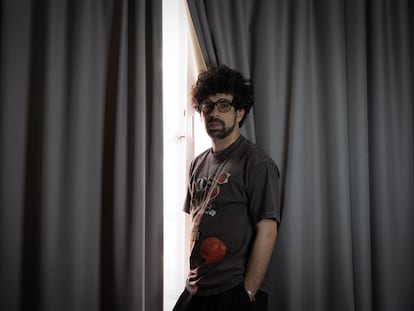Miguel Díaz-Canel and the mission of humanizing Castro’s heir
With Cuba immersed in an economic and humanitarian crisis from which it cannot escape, the president — who succeeded Fidel and Raúl Castro — is attempting to get closer to the citizenry

This past September 25, Miguel Díaz-Canel Bermúdez, 63, left New York City and landed at José Martí International Airport. The Cuban president returned to a country that is in the grip of its biggest crisis since 1959.
Some weeks later — well-rested after his trip — he sat down for an interview with state journalist Arleen Rodríguez Derivet amidst the mahogany furniture of his office in the Palace of the Revolution, in Havana. The interview — rehearsed beforehand and edited afterward — was transmitted to the Cuban people in the night.
Díaz-Canel — who was born just a year after the triumph of the Cuban Revolution and who celebrated his first birthday the day after the Bay of Pigs Invasion ended — looks very different from Fidel and Raúl Castro when the two brothers took power (they were only in their early-30s at the time). In the past five years since he became president, his hair has turned completely gray. His facial features — which the state channel’s makeup artists have tried to hide with foundation and concealer — look aged. He wears brown Oxford-style shoes, dark pants and a sky-blue shirt. This is his typical wardrobe: he never wears the military uniforms that the Castro brothers were so fond of. He usually appears in lightly-starched guayaberas, straw hats, or baseball caps.
There were those who once thought that Díaz-Canel had an ace up his sleeve, that he would change the future of Cuba. His schoolmates have told the state media that, as a young man, he listened to the Beatles on a Philips radio, when music in English was demonized in the country for “ideological reasons.”
In an old photo, he appears in a sweater and tight jeans, with long hair down to the nape of his neck. At his side, Fidel Castro is wearing his usual olive green. It was the beginning of the 1990s and the electrical engineer Miguel Díaz-Canel Bermúdez — then in his early-30s, the descendant of Spanish immigrants — was rising through the ranks of the Young Communist League (UJC). In 1994, the son of a factory worker and a schoolteacher became first secretary of the Provincial Committee of the Communist Party in the province of Villa Clara. Thus began his firmly-planted steps towards the hardline politics of the country.
“Díaz Canel was a great leader here in the province,” says Jacqueline, 55, from the city of Santa Clara. This is where the ruler was born and developed much of his leadership career. “The people admired him a lot and they also supported him. He didn’t allow any company that was tasked with producing food to [cheat] the people.”
Many remember him riding a bicycle, or supporting the shows at the local club El Mejunje, a meeting place for the LGBTQ community that some communist leaders denigrated. Other residents of Villa Clara, however, detested his administration: “History is going to [punish him] for abusing the people,” says a resident, who asks to remain anonymous. “In the end, he’s not the only one responsible — he’s just one more from that litter [of rulers].”
Beyond the handful of photos of the two men together, very little is known about the relationship between Díaz-Canel and Fidel Castro. The first has said that once — using his influence in Santa Clara — he packed a square in a few hours for the second to give a speech. At that moment, he gained some sympathy from Castro. Another time, reporters asked Díaz-Canel about how he had met Fidel. He responded: “[I knew him for] as long as I can remember. He was my boss, but I’ve known him and loved him since I was a child,” he wrote on X in 2021.
With Raúl Castro, 92, it is said that he had a closer relationship. They met at an event at the Villa Clara Defense School, when Díaz-Canel was secretary of the Provincial Committee of the UJC. In 2003, Raúl made him leader of the province of Holguín and promoted his candidacy to the Politburo of the Communist Party. In 2009, the younger Castro placed the Ministry of Higher Education in his hands. In 2013, Díaz-Canel became his successor, when he was named first vice president of the Councils of Ministers. And, in 2018, when Raúl Castro left the presidency to remain in the position of general secretary of the party, his protégée became president of the Republic of Cuba, at the age of 57. He’s “not an upstart nor an improviser,” according to the younger Castro brother.
Today, in his office — next to a portrait on the bookshelf in which he appears affectionately with his wife, Lis Cuesta — there’s a photo of Fidel, who died two years before his rise to the presidency. The leader of the Cuban Revolution died at the age of 90 with the conviction that no one beyond his family would ever occupy the throne of the island.
Many Cubans have wondered about the reason why the interview with Díaz-Canel was broadcast. Some think that this it’s an attempt by the regime to “humanize” him — to show the public that he may be a president, but he’s also a person who gets tired, makes mistakes and tries to rectify them. However, Díaz-Canel doesn’t really need an interview to do this, because he practices the strategy on a daily basis. He is — perhaps unintentionally — the man who has contributed the most to the meme industry in the country. He always carries a tablet with him and boasts of having more than 760,000 followers on X.
“I think I have more followers than anyone in Cuba… although I’m not sure,” he chuckled, in a recent interview with The Nation. When asked if he preferred Oppenheimer or Barbie, he replied that while he was very interested in seeing Christopher Nolan’s film, he didn’t seem interested in Greta Gerwig’s blockbuster hit. “It seems to me that Barbie is very light,” he opined.
Díaz-Canel speaks slowly. He has declared himself a fan of FC Barcelona and, in 2021, he obtained his doctorate in technical sciences. He also coined a phrase that has been a widely-ridiculed in Cuba: “Lemonade is the basis of everything.” He uttered it when, on one occasion, he tried to publicly offer alternatives to the food crisis in the country. He’s also been criticized for using the word “conjuncture” to describe the economic crisis that has been worsening by the day since 2019.
The president has frequently been booed in public. He was called out in the Regla municipality, in Havana, when he made an appearance after a tornado hit. They threw plastic water bottles at him in San Antonio de Los Baños when he showed up in an attempt to quell the massive protests of July 11, 2021. He will go down in history for having put more than 1,000 people behind bars for demonstrating, converting them into political prisoners overnight.
But who really is Díaz-Canel? And what weight does he have in today’s Cuba? Even with Raúl Castro no longer formally present in the Communist Party, his long shadow extends over the island. Cuban historian and essayist Rafael Rojas maintains that his vision of Díaz-Canel’s leadership represents a shift away from the rigid imperial presidency. “Díaz Canel occupies a new position — the presidency of the Republic — which perhaps has more institutional powers than the former [role of] president of the Councils of Ministers. He’s also the general secretary of the Communist Party, which he may not fully control, just as he doesn’t even partially control the army. But that position assures him supreme command in the next presidential succession, in 2028, when Raúl will probably be gone. [By then], he will remain as the party’s top leader, for a time, to control the transfer of executive power. This isn’t a small thing, in my opinion.”
Very little is known about what the president enjoys, beyond some photos of him sharing a meal with friends, dancing at a private concert, or taking a trip in his armored BMW. However, a bit more is known about his family. He has two children from his marriage to Marta Villanueva, a dentist from Villa Clara. He’s also a grandfather.
Lis Cuesta — Díaz-Canel’s second wife — isn’t a mysterious character like Dalia Soto del Valle, Fidel Castro’s widow. Cuesta — known for her $17,000 Hermés bags, her numerous designer dresses and her penchant for rich food — isn’t officially the country’s first lady, but behaves as if she were. A graduate of the Institute of Pedagogical Sciences in Holguín, she defines herself on social media as an events coordinator for the Ministry of Culture and as a “grandmother, revolutionary and teacher.” Cuesta accompanies Díaz-Canel on his trips around the world. Since November of 2021, she has visited about 21 countries with her husband, whom she constantly defends on social media. She also professes a lot of affection for him publicly: “He’s so cute!” reads one of her tweets. “And, furthermore, inside and out, [he’s] the dictator of my heart.”
The last interview with Díaz-Canel in his stately office took place after Cuba’s ministers of Finance, Energy and Mines appeared on national television to inform the public that, effectively, there is no fuel for transportation, not enough electricity to watch soap operas, no coffee for the mornings and no food for the afternoons. Subsequently, the president attempted to justify why the country has ended up in what he calls a “complex situation,” with high inflation, failed economic planning, banking upheavals, fuel shortages, low salaries and a mass exodus of people.
In the interview, the journalist — in order to throw a lifejacket to the president from the start — tells him that he hasn’t had it easy in his five years in office. During his tenure, the second-deadliest aircraft accident in Cuban history took place, in which 112 people died. The Díaz-Canel administration also contended with the pandemic and the resulting decline in tourism (a crucial industry in Cuba), along with a tornado that destroyed several municipalities in Havana. There have also been gas explosions at the historic Hotel Saratoga and the Matanzas oil storage facility, which left 46 and 12 people dead respectively. So, does the president think he’s been unlucky?
To the question, Díaz-Canel answers that it’s not about luck. In his opinion — as always — it’s about the U.S. embargo and the various crises around the world. He then pivots to talk about other matters, such as the need for “creative resistance” and his policies against racism and gender-based violence. He uses the word “revolutionary” a few times… but nobody in Cuba knows what it means to be a revolutionary anymore. Normally, Díaz-Canel uses words or phrases that he inherited from Castroism, such as “change what must be changed” or turn “setbacks into victories.” Nobody really understands what exactly he’s referring to. In the parliamentary elections this past March — in which members of the National Assembly (and not the people) re-elected Díaz-Canel — the government scored the worst electoral result in its history, with an abstention rate of 31.42%.
Rojas assures EL PAÍS that it has been a constant in Díaz-Canel’s leadership to combine “a discreet sympathy for economic openness (liberalization), with a continuous ideological and culturally conservative discourse.” He also notes that, although there’s probably an attempt on the president’s part to please both the reformist and hardline sectors of the leadership, “the consistency that he has shown in the last five years speaks more to pragmatism. We shouldn’t expect bigger shakeups, even after the death of Raúl Castro.” The historian believes that Díaz-Canel would only move away from the current script if his power is threatened.
The Cuban president — under the weight of being the heir of the Castros — will be remembered for many reasons. During his tenure, the largest exodus in the history of the island has taken place, while the country has reached a level of economic depression unseen in 60 years. As he searches for the magic formula to redirect the course of the island — while simultaneously promising that he will continue to support socialism — he keeps walking two or three miles a day, swimming and doing weight-training on the weekends to stay in shape.
In 2018, Raúl Castro called Díaz-Canel “the only survivor.” Neither former foreign ministers Roberto Robaina or Felipe Pérez Roque — nor former vice president Carlos Lage — had remained in charge of the country. The notion that Cuba would experience a change in the future has been confronted by the reality that the country, today, has collapsed. Gone are the days when Raúl Castro sat down to talk with Barack Obama and injected a breath of fresh air into the lagging economy.
Sign up for our weekly newsletter to get more English-language news coverage from EL PAÍS USA Edition
Tu suscripción se está usando en otro dispositivo
¿Quieres añadir otro usuario a tu suscripción?
Si continúas leyendo en este dispositivo, no se podrá leer en el otro.
FlechaTu suscripción se está usando en otro dispositivo y solo puedes acceder a EL PAÍS desde un dispositivo a la vez.
Si quieres compartir tu cuenta, cambia tu suscripción a la modalidad Premium, así podrás añadir otro usuario. Cada uno accederá con su propia cuenta de email, lo que os permitirá personalizar vuestra experiencia en EL PAÍS.
¿Tienes una suscripción de empresa? Accede aquí para contratar más cuentas.
En el caso de no saber quién está usando tu cuenta, te recomendamos cambiar tu contraseña aquí.
Si decides continuar compartiendo tu cuenta, este mensaje se mostrará en tu dispositivo y en el de la otra persona que está usando tu cuenta de forma indefinida, afectando a tu experiencia de lectura. Puedes consultar aquí los términos y condiciones de la suscripción digital.
More information
Archived In
Últimas noticias
Maduro pleads not guilty before the federal court in New York: ‘I am still the president of Venezuela’
A new test can detect Alzheimer’s from a finger prick
UN team enters Sudanese city of El Fasher after paramilitary massacre: ‘It’s like a ghost town’
A recipe for resistance: Indigenous peoples politicize their struggles from the kitchen
Most viewed
- Gilles Lipovetsky: ‘If you want to live better and fall in love, take Prozac, don’t look to philosophy’
- Alain Aspect, Nobel laureate in physics: ‘Einstein was so smart that he would have had to recognize quantum entanglement’
- Alvin Hellerstein, a 92-year-old judge appointed by Bill Clinton, to preside over Maduro’s trial in New York
- Why oil has been at the center of Venezuela-US conflicts for decades
- Maduro’s downfall puts China’s relationship with Venezuela to the test










































